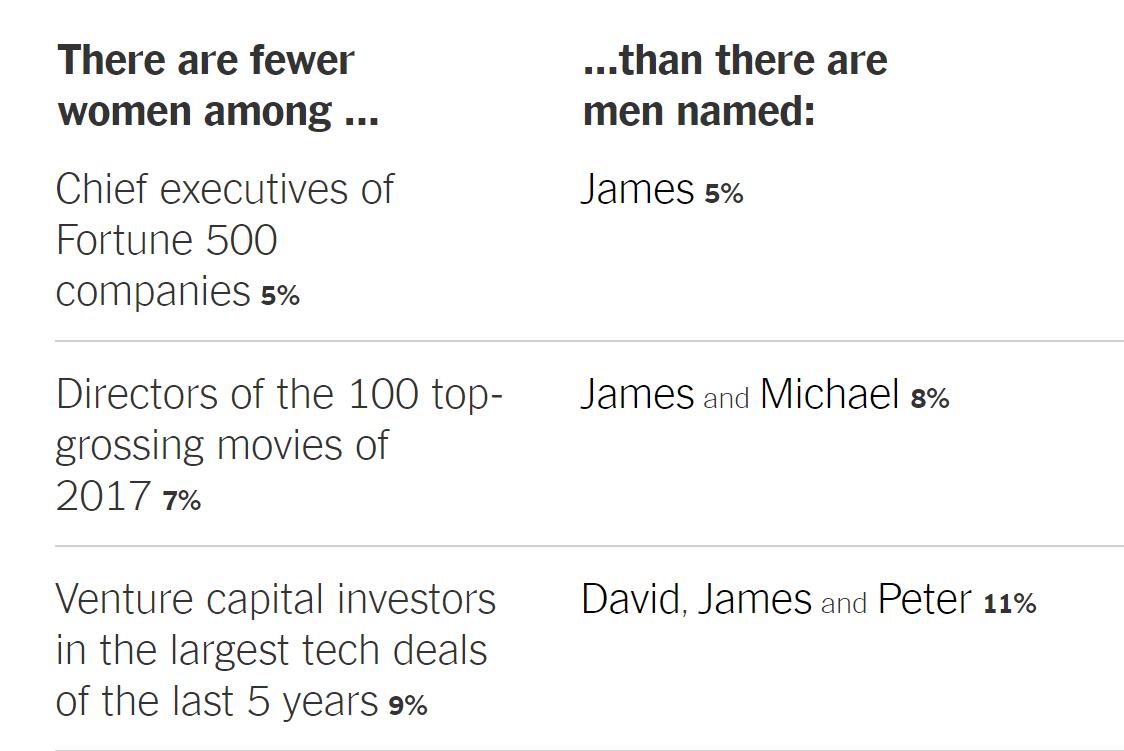“Are leadership development programs specifically for women really necessary? It’s 2020!”
Yes, believe it or not, this is an objection some of our coaches have heard and had to overcome. While to me the answer feels obvious, it never hurts (too much) to step back and make a good faith effort to answer the question in earnest. What are the benefits of a women’s leadership program? Why is it needed in a modern work environment?
Of course, advancements have been made! 29%1 of senior management roles globally are now held by women – the most in history (so far). But when women represent 50%1 of the work force, we’re still missing the mark. The numbers in the image below from a 2018 New York Times article2 offer a lighthearted lens through which to look at the disparity. But nonetheless, they reveal that the road to true gender equality is long and winding.

Many organizations feel that they aren’t ready – or just don’t have the right buy-in from key advocates – to tackle this issue in a meaningful way. There are many other organizations out there, however, who are committed to doing the hard work required to start closing the gap. There are a few key activities they are engaging in to ensure that they’re making progress:
- They are setting parity goals and stating them publicly.
- They are showing women that they are ready and willing to invest in them.
- They are building programs that reflect the differences in the way women lead and investing in their learning and development needs.
Our research – drawn from three decades of global leadership data – indicates that women and men exhibit some noteworthy differences in the behaviors they emphasize as leaders. These differences can impact a leader’s perceived effectiveness and “promotability.” That’s why it’s critical for learning and development efforts to take those differences into account.
Research we conducted in 2019 indicated that women leaders can increase their perceived effectiveness by focusing on a few specific behaviors:
- Being more convincing and persuasive
- Delegating more frequently, and in a way that gives others autonomy
- Giving more weight to the lessons of the past in decision-making
These behaviors are among the foundational elements of the Ignite: Women in Leadership program that MRG recently developed for a large humanitarian organization pursuing aggressive gender parity goals.
I had the privilege of being part of the delivery team for the first two cohorts of this program, and the impact was staggering. Many of the women came in with some misgivings about a program specifically for women leaders. A few even expressed concern for their male colleagues being “left behind” or “missing out” on the opportunity – though they acknowledged that they had not been given similar opportunities in the past, but accepted it as the norm. As I listened, I was struck by the inherent disparities that we have been socialized to accept.
Over the course of four days, I watched a powerful wave of change ripple through the room. Two dozen women engaged in the intensive residential program, which included: peer coaching; when to lead vs. when to manage; overcoming limiting beliefs to find a clear voice; and building a delegation toolkit.
I watched as the participants discovered that it was not only okay to lead differently, but that there may in fact be benefits to their approach over that of the men who have mentored them. They embraced the community and safety of the 24 other women surrounding them, having shared many of the same experiences. They revealed deep truths and opened up dialogue that might not have happened in a mixed-gender group. They left feeling seen, connected to a new mission, and empowered to mobilize, carrying on this work within their organization.
Approaching learning and development from within a community of people who have shared life experiences and who face similar obstacles is undeniably powerful. Participants in programs like this emerge not only with an expanded skill set, but with an increased confidence in their ability to take on the leadership role from a place of authenticity.
I have seen first-hand the powerful impact these newly empowered leaders can have when they return to their roles within their organizations and it’s incalculable.
So every time I get the question about whether development designed for the advancement of women is still necessary, my answer will always be an enthusiastic “yes.”
1Grant Thornton, Women in Business: Building a Blueprint for Action (2019): p. 5.
2Claire Cain Miller, Kevin Quealy, and Margot Sanger-Katz, “The Top Jobs Where Women Are Outnumbered by Men Named John,” The New York Times, April 24. 2018

Yes, indeed, there is still a need for women’s leadership programs. I was recently talking to Sally Helgesen about how women’s and men’s leadership experiences differ. Of course that’s why she wrote her new book — to put “advice for people” into the social dialect of “advice that fits women.” I find that the young women I coach and mentor now face many of the same issues I faced decades ago as a young MBA or rising manger. That’s why I’m conducting a new study of women and their work, and how women lead, in preparation for a webinar presentation… Read more »
Thanks for your comment, Deborah. I recently met Sally at an event in San Diego…she’s great. We would love to compare research notes with you. Please feel free to connect with me directly at staci.nisbett@mrg.com.